As Halloween nears, readers of all ages enjoy listening to and reading stories about witches, ghosts, monsters, and other creepy creatures. This week’s column includes slightly spooky stories for younger readers and terrifying tales for older readers. Give students a special treat by sharing these recently published books alongside classic Halloween tales.
Ages 4–8
Bone Soup: A Spooky Tasty Tale. Alyssa Satin Capucilli. Ill. Tom Knight. 2018. Paula Wiseman/Simon & Schuster.
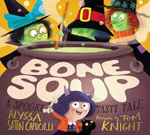 In this retelling of the folktale “Stone Soup,” Knight uses lush colors to illustrate the friendly monster, ghost, vampire, mummy, skeleton, and other creatures who fill the cauldron of three little witches with spooky ingredients to make a tasty soup. Capucilli fills the book with humorous descriptive language like “wrinkliest of prunes” and “slimy sludge” that make reading this book a treat. The repeated words and phrases will appeal to beginning readers. A recipe for bone soup is included so children and their caregivers can make their own tasty Halloween treat.
In this retelling of the folktale “Stone Soup,” Knight uses lush colors to illustrate the friendly monster, ghost, vampire, mummy, skeleton, and other creatures who fill the cauldron of three little witches with spooky ingredients to make a tasty soup. Capucilli fills the book with humorous descriptive language like “wrinkliest of prunes” and “slimy sludge” that make reading this book a treat. The repeated words and phrases will appeal to beginning readers. A recipe for bone soup is included so children and their caregivers can make their own tasty Halloween treat.
—CT
Ghoulia (Ghoulia #1). Barbara Cantini. Trans. Anna Golding. 2018. Amulet/Abrams.
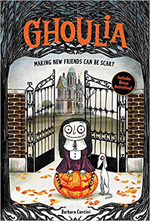 This first book in a series imported from Italy, with ghoulishly detailed Tim Burton-style illustrations, introduces Ghoulia, “a perfectly normal zombie girl,” and the other residents of Crumbling Manor, including Tragedy (her albino greyhound), Auntie Departed, Shadow (Auntie’s cat), Uncle Misfortune (actually, just his head), and Grandad Coffin (a ghost). When Ghoulia overhears some children talking about dressing up in scary costumes and going trick-or-treating on Halloween night, she has the brilliant idea to disguise herself “as a normal, living child.” All is going well until Ghoulia forgets and demonstrates her special scary move, which reveals her true identity. All ends well, as the children (after three pages of staring) realize how incredible it is to have a friend who is “a REAL ZOMBIE!!!”
This first book in a series imported from Italy, with ghoulishly detailed Tim Burton-style illustrations, introduces Ghoulia, “a perfectly normal zombie girl,” and the other residents of Crumbling Manor, including Tragedy (her albino greyhound), Auntie Departed, Shadow (Auntie’s cat), Uncle Misfortune (actually, just his head), and Grandad Coffin (a ghost). When Ghoulia overhears some children talking about dressing up in scary costumes and going trick-or-treating on Halloween night, she has the brilliant idea to disguise herself “as a normal, living child.” All is going well until Ghoulia forgets and demonstrates her special scary move, which reveals her true identity. All ends well, as the children (after three pages of staring) realize how incredible it is to have a friend who is “a REAL ZOMBIE!!!”
—CA
A Samurai Scarecrow: A Very Ninja Halloween. Rubin Pingk. 2018. Simon & Schuster.
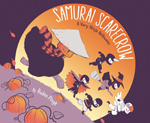 After telling his little sister Kashi about the Samurai Scarecrow, who wakes when the moon is full and vows to teach “the feathered fools who won’t flee” to be scared of him, Yukio, who considers himself to be a brave ninja, decides to dress up as a bird. When Kashi, who has been copying all his Halloween preparations, appears in a matching Ninja Bird costume, Yukio has had enough. His cruel words—“You’re not a real Ninja!”—make Kashi decide not to go trick-or-treating with him. Instead, she plays a clever ninjalike trick on Yukio at the end of the evening. The action-filled digital illustrations, done in black and white with orange accents against a mauve background, add to the fun of this “very ninja Halloween” tale.
After telling his little sister Kashi about the Samurai Scarecrow, who wakes when the moon is full and vows to teach “the feathered fools who won’t flee” to be scared of him, Yukio, who considers himself to be a brave ninja, decides to dress up as a bird. When Kashi, who has been copying all his Halloween preparations, appears in a matching Ninja Bird costume, Yukio has had enough. His cruel words—“You’re not a real Ninja!”—make Kashi decide not to go trick-or-treating with him. Instead, she plays a clever ninjalike trick on Yukio at the end of the evening. The action-filled digital illustrations, done in black and white with orange accents against a mauve background, add to the fun of this “very ninja Halloween” tale.
—CA
Skelly’s Halloween. David Martin. Ill. Lori Richmond. 2018. Henry Holt.
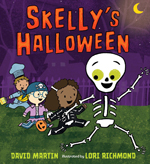 “Head and shoulders, knees and toes. / Trick-or-treating, here we goes!” Skelly Bones Skeleton’s Halloween plans go awry when a gust of wind catches his “BOOOO-tiful” ghost costume and tosses him up into the air, and he lands with his bones scattered. The silly appearances of Skelly, the result of asking a snake and then a colony of ants for help in reassembling his bones, is a highlight in the colorful artwork (created with pen and ink, foam stamps, and Adobe Photoshop). Finally, a trio of children put Skelly together again by following the pattern of bones on a girl’s skeleton costume and invite him to join their night of trick-or-treating fun.
“Head and shoulders, knees and toes. / Trick-or-treating, here we goes!” Skelly Bones Skeleton’s Halloween plans go awry when a gust of wind catches his “BOOOO-tiful” ghost costume and tosses him up into the air, and he lands with his bones scattered. The silly appearances of Skelly, the result of asking a snake and then a colony of ants for help in reassembling his bones, is a highlight in the colorful artwork (created with pen and ink, foam stamps, and Adobe Photoshop). Finally, a trio of children put Skelly together again by following the pattern of bones on a girl’s skeleton costume and invite him to join their night of trick-or-treating fun.
—CA
Stumpkin. Lucy Ruth Cummins. 2018. Atheneum/Simon & Schuster.
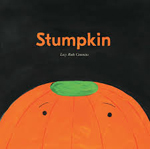 Stumpkin is nearly the perfect pumpkin. He is as orange as a traffic cone and as big as a basketball. But Stumpkin has no stem. Halloween is coming, and all of Stumpkin’s friends are picked to be carved into be jack-o-lanterns—even the gourd! Will he ever get chosen to be a jack-o-lantern? Lucy Ruth Cummins uses a minimal color scheme to keep the focus on the bright orange pumpkins. The striking inclusion of two completely black pages toward the end of the book helps to build suspense as the reader awaits the fate of Stumpkin. Young readers will enjoy the happy ending and the carved faces of the pumpkins in the windows.
Stumpkin is nearly the perfect pumpkin. He is as orange as a traffic cone and as big as a basketball. But Stumpkin has no stem. Halloween is coming, and all of Stumpkin’s friends are picked to be carved into be jack-o-lanterns—even the gourd! Will he ever get chosen to be a jack-o-lantern? Lucy Ruth Cummins uses a minimal color scheme to keep the focus on the bright orange pumpkins. The striking inclusion of two completely black pages toward the end of the book helps to build suspense as the reader awaits the fate of Stumpkin. Young readers will enjoy the happy ending and the carved faces of the pumpkins in the windows.
—CT
Ages 9–11
The Ghostly Carousel: Delightfully Frightful Poems. Calef Brown. 2018. Carolrhoda/Lerner.
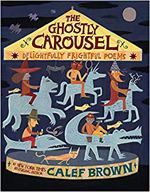 Brown’s anthology of 17 humorous poems and seasonally colored illustrations are more likely to induce groans and giggles than fright, making them a delightful choice for those who like their Halloween reading to be scary, but not too scary. The verses, filled with puns, alliteration, and clever wordplay, introduce a motley crew of characters, including Joel, a zombie eager to escape the hugs of his zombified aunts at a family reunion; the Gambling Ghost, an expert at rolling haunted dice; a telekinetic warlock, who “can easily open door locks” with his magical mind; and Hank, who says that “grubs and larvae make marvelous food.” (Hank’s recipe for insect pie is included in another poem.)
Brown’s anthology of 17 humorous poems and seasonally colored illustrations are more likely to induce groans and giggles than fright, making them a delightful choice for those who like their Halloween reading to be scary, but not too scary. The verses, filled with puns, alliteration, and clever wordplay, introduce a motley crew of characters, including Joel, a zombie eager to escape the hugs of his zombified aunts at a family reunion; the Gambling Ghost, an expert at rolling haunted dice; a telekinetic warlock, who “can easily open door locks” with his magical mind; and Hank, who says that “grubs and larvae make marvelous food.” (Hank’s recipe for insect pie is included in another poem.)
—CA
Nightbooks. J. A. White. 2018. Katherine Tegen/HarperCollins.
 Alex loves writing scary stories in his “nightbooks.” On his way to destroy all his nightbooks, in an effort to be “less weird” and more like everyone else, Alex is drawn into an apartment by the sounds of his favorite horror movie. Alex quickly realizes that this is no ordinary apartment and that he has been lured to the apartment to tell scary stories to a witch. In the giant magical library, he learns about the Unicorn Girl, the only person to ever escape the apartment. Alex enlists the help of the hesitant Yasmin (another prisoner) and Lenore (a grumpy cat who is keeping an eye on the two children) to form an escape plan. The novel includes Alex’s stories, which are genuinely creepy without gore. Elements of spookiness and magic in this horror story will appeal to a wide range of middle-grade readers.
Alex loves writing scary stories in his “nightbooks.” On his way to destroy all his nightbooks, in an effort to be “less weird” and more like everyone else, Alex is drawn into an apartment by the sounds of his favorite horror movie. Alex quickly realizes that this is no ordinary apartment and that he has been lured to the apartment to tell scary stories to a witch. In the giant magical library, he learns about the Unicorn Girl, the only person to ever escape the apartment. Alex enlists the help of the hesitant Yasmin (another prisoner) and Lenore (a grumpy cat who is keeping an eye on the two children) to form an escape plan. The novel includes Alex’s stories, which are genuinely creepy without gore. Elements of spookiness and magic in this horror story will appeal to a wide range of middle-grade readers.
—CT
Scream and Scream Again!: Spooky Stories from Mystery Writers of America. R. L. Stine (Ed.) 2018. HarperCollins.
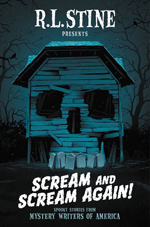 R. L. Stine and 20 other members of the Mystery Writers of America contribute to this anthology of spooky short stories, each of which begins or ends with a scream, or better yet, begins and ends with a scream. For example, Bruce Hale begins “Raw Head and Bloody Bones” with “Screams ripped the suburban October afternoon in two like a construction paper pumpkin. ‘AAAHH!’” and ends the story with “And once more, screams pierced the suburban night.” The stories are suspenseful and feature surprising twists that add to the fun of reading them aloud.
R. L. Stine and 20 other members of the Mystery Writers of America contribute to this anthology of spooky short stories, each of which begins or ends with a scream, or better yet, begins and ends with a scream. For example, Bruce Hale begins “Raw Head and Bloody Bones” with “Screams ripped the suburban October afternoon in two like a construction paper pumpkin. ‘AAAHH!’” and ends the story with “And once more, screams pierced the suburban night.” The stories are suspenseful and feature surprising twists that add to the fun of reading them aloud.
—CA
Ages 12–14
Pitch Dark. Courtney Alameda. 2018. Feiwel and Friends.
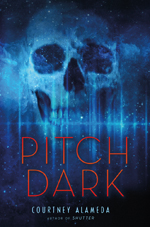 Laura Cruz wants to rid herself of an implanted subjugator, and Tuck Morgan just woke up from being in stasis for a few hundred years. A crash between their two ships brings their worlds together. The crew on the Conquistador, Laura’s ship, is searching for the last bits of human history and the John Muir, Tuck’s ship, has one of the last pieces of history that could be the key to saving humanity. Laura and Tuck must work together while escaping griefers, mourners, and even other humans. There is plenty of action and scientific language in this action-packed book. An unexpected twist will keep readers interested until the very end of this science fiction thriller.
Laura Cruz wants to rid herself of an implanted subjugator, and Tuck Morgan just woke up from being in stasis for a few hundred years. A crash between their two ships brings their worlds together. The crew on the Conquistador, Laura’s ship, is searching for the last bits of human history and the John Muir, Tuck’s ship, has one of the last pieces of history that could be the key to saving humanity. Laura and Tuck must work together while escaping griefers, mourners, and even other humans. There is plenty of action and scientific language in this action-packed book. An unexpected twist will keep readers interested until the very end of this science fiction thriller.
—CT
Small Spaces. Katherine Arden. 2018. Putnam/Penguin.
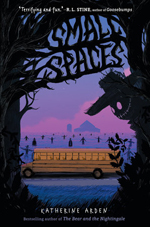 Ollie is on her way home from school when she sees a strange woman throwing a book called Small Spaces into the water. Ollie rescues the book and quickly becomes engrossed in the story. When Ollie’s class goes on a field trip to a farm, the bus driver gives Ollie strange advice: “Avoid large spaces at night. Keep to small.” On the way home, the bus breaks down. It’s nearly dark when Ollie escapes into the woods joined by Coco, a city girl who gets upset at the drop of a hat, and Brian, a hockey player who quotes Alice in Wonderland. They aren’t alone in the woods, as they encounter creepy scarecrows that seem to follow them. An unexpected source helps the three work together to solve a mystery that comes straight from the book Ollie has been reading. This fast-paced book will be enjoyed by middle-grade readers, particularly those who like spooky, but not too scary, stories.
Ollie is on her way home from school when she sees a strange woman throwing a book called Small Spaces into the water. Ollie rescues the book and quickly becomes engrossed in the story. When Ollie’s class goes on a field trip to a farm, the bus driver gives Ollie strange advice: “Avoid large spaces at night. Keep to small.” On the way home, the bus breaks down. It’s nearly dark when Ollie escapes into the woods joined by Coco, a city girl who gets upset at the drop of a hat, and Brian, a hockey player who quotes Alice in Wonderland. They aren’t alone in the woods, as they encounter creepy scarecrows that seem to follow them. An unexpected source helps the three work together to solve a mystery that comes straight from the book Ollie has been reading. This fast-paced book will be enjoyed by middle-grade readers, particularly those who like spooky, but not too scary, stories.
—CT
Ages 15+
The Dark Descent of Elizabeth Frankenstein. Kiersten White. 2018. Delacorte/Random House.
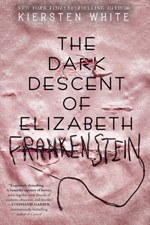 Kiersten White’s imaginative retelling of Mary Shelley’s Frankenstein (1818) is told from the point of view of 17-year-old Elizabeth Lavenza, who, at the age of 5, was rescued from an abusive caregiver and taken in by the Frankensteins to be a companion for Victor in the hope that she might help socialize their brilliant eldest son. Over the years, Elizabeth becomes not just his companion but also his friend and protector; she becomes Victor’s Elizabeth. When he leaves home to pursue his studies in science, Elizabeth fears dismissal from the family. After almost two years without letters from Victor, she sets out with her friend Justine (the governess of the two young Frankenstein boys) to find him. When Elizabeth discovers the horrors of the scientific experiments he is undertaking in his lab in Germany, she realizes that she must save him from the monster he has created—and from himself. White effectively uses inserts in italics to provide details of the backstory of their relationship throughout her suspenseful, psychological horror story as she builds toward a dark Gothic conclusion.
Kiersten White’s imaginative retelling of Mary Shelley’s Frankenstein (1818) is told from the point of view of 17-year-old Elizabeth Lavenza, who, at the age of 5, was rescued from an abusive caregiver and taken in by the Frankensteins to be a companion for Victor in the hope that she might help socialize their brilliant eldest son. Over the years, Elizabeth becomes not just his companion but also his friend and protector; she becomes Victor’s Elizabeth. When he leaves home to pursue his studies in science, Elizabeth fears dismissal from the family. After almost two years without letters from Victor, she sets out with her friend Justine (the governess of the two young Frankenstein boys) to find him. When Elizabeth discovers the horrors of the scientific experiments he is undertaking in his lab in Germany, she realizes that she must save him from the monster he has created—and from himself. White effectively uses inserts in italics to provide details of the backstory of their relationship throughout her suspenseful, psychological horror story as she builds toward a dark Gothic conclusion.
—CA
The Price Guide to the Occult. Leslye Walton. 2018. Candlewick.
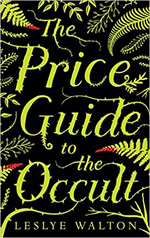 All Nor Blackburn wants is to live an unremarkable teenage life. That all changes when an obscure book, The Price Guide to the Occult, starts to mysteriously grow in popularity. The price for the spells isn’t just money, however; something bad happens to another person whenever a spell is cast. Nor knows that she comes from the powerful Blackburn family line of witches, but she doesn’t know how powerful she is until she is forced to come face to face with the witch performing the black magic behind the book’s spells. Walton keeps the reader’s interest through to the action-packed showdown. The end is graphic and disturbing, so this dark, horrific fantasy is definitely for more mature readers.
All Nor Blackburn wants is to live an unremarkable teenage life. That all changes when an obscure book, The Price Guide to the Occult, starts to mysteriously grow in popularity. The price for the spells isn’t just money, however; something bad happens to another person whenever a spell is cast. Nor knows that she comes from the powerful Blackburn family line of witches, but she doesn’t know how powerful she is until she is forced to come face to face with the witch performing the black magic behind the book’s spells. Walton keeps the reader’s interest through to the action-packed showdown. The end is graphic and disturbing, so this dark, horrific fantasy is definitely for more mature readers.
—CT
Carrie Thomas is a reading specialist at First Philadelphia Charter School. Previously, she was a public school music teacher and worked with nonprofit administration and outreach. Carolyn Angus is former director of the George G. Stone Center for Children's Books, Claremont Graduate University, in Claremont, California.
These reviews are submitted by members of the International Literacy Association's Children's Literature and Reading Special Interest Group (CL/R SIG) and are published weekly on Literacy Daily.